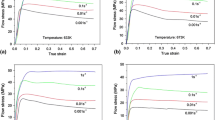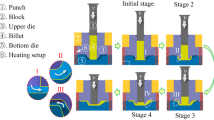Abstract
The design of preform plays a key role in the precision forming of complex-shaped components with thin walls and large areas of webs. In the present work, two typical kinds of box-shaped forgings of 5A06 aluminum-alloy were selected as research objects, including the symmetric rectangular base forging and the asymmetric arc cover forging. The preform design method was proposed during isothermal back extrusion of boxlike forging, in which metal flow law of billets with equal thickness revealed by finite element (FE) simulation was quite useful for the billet design. The simulation results successfully predicted folding defects at the bottom of the base forging and inadequate filling at lateral walls of the cover forging, which were caused by inappropriate billet geometry and loading mode. According to the simulation and experimental results, the reverse loading of the rectangular base billet with variable thickness avoided the appearance of the folding at the bottom. The base forging without defects was formed successfully under reverse loading by using the billet with four 60 mm × 90 mm × 5 mm bosses and 15° transition surfaces, while the cover forging without defects was formed successfully by using the billet with 15° transition surfaces and two bosses whose heights were both 48 mm. Both the two boxlike forgings formed with modified billets exhibited perfect distribution of flow lines. Meanwhile, the lateral walls and webs possessed higher tensile strength, higher elongation, finer and more elongated grains than raw material. Therefore, the thermal backward extrusion was an effective process to precisely form complexly boxlike rib/web workpiece.






















Similar content being viewed by others
References
Hu JL, Yi YP, Huang SQ (2015) Experimental study and microstructure analysis of aviation component by isothermal forging process. Mater Manuf Process 30:79–84. https://doi.org/10.1080/10426914.2014.941866
Luo W, Chen F, Xu BB, Yang ZJ, Guo YM, Lu B, Huang T (2018) Study on compound spinning technology of large thin-walled parts with ring inner ribs and curvilinear generatrix. Int J Adv Manuf Technol 98:1199–1216. https://doi.org/10.1007/s00170-018-2334-x
Deng L, Wang XY, Jin JS, Xia JC (2018) Precision forging technology for aluminum alloy. Front Mech Eng 13:25–36. https://doi.org/10.1007/s11465-018-0477-y
Li BH, Gao HJ, Deng HB, Wang C (2020) A machining deformation control method of thin-walled part based on enhancing the equivalent bending stiffness. Int J Adv Manuf Technol 108:2775–2790. https://doi.org/10.1007/s00170-020-05585-3
Yuan L, Zhao Z, Shi WC, Xu FC, Shan DB (2015) Isothermal forming of the large-size AZ80A magnesium alloy forging with high mechanical properties. Int J Adv Manuf Technol 78:2037–2047. https://doi.org/10.1007/s00170-014-6780-9
Shan DB, Wang Z, Lu Y, Xue KM (1997) Study on isothermal precision forging technology for a cylindrical aluminium-alloy housing. J Mater Process Technol 72:403–406. https://doi.org/10.1016/S0924-0136(97)00202-1
He HL, Huang SQ, Yi YP, Guo WF (2017) Simulation and experimental research on isothermal forging with semi-closed die and multi-stage-change speed of large AZ80 magnesium alloy support beam. J Mater Process Technol 246:198–204. https://doi.org/10.1016/j.jmatprotec.2017.03.015
Kim YH, Ryou TK, Choi HJ, Hwang BB (2002) An analysis of the forging processes for 6061 aluminum-alloy wheels. J Mater Process Technol 123:270–276. https://doi.org/10.1016/S0924-0136(02)00087-0
Petrov P, Perfilov V, Stebunov S (2006) Prevention of lap formation in near net shape isothermal forging technology of part of irregular shape made of aluminium alloy A92618. J Mater Process Technol 177:218–223. https://doi.org/10.1016/j.jmatprotec.2006.03.206
Dong WP, Chen J (2008) 3D FEA simulation of 4A11 piston skirt isothermal forging process. Trans Nonferrous Metals Soc China 18:1196–1200. https://doi.org/10.1016/S1003-6326(08)60204-6
Zhang YQ, Jiang SY, Zhao YN, Shan DB (2013) Isothermal precision forging of complex-shape rotating disk of aluminum alloy based on processing map and digitized technology. Mater Sci Eng A 580:294–304. https://doi.org/10.1016/j.msea.2013.05.059
Xia XS, Xiao L, Chen Q, Li H, Tan YJ (2018) Hot forging process design, microstructure, and mechanical properties of cast Mg–Zn–Y–Zr magnesium alloy tank cover. Int J Adv Manuf Technol 94:4199–4208. https://doi.org/10.1007/s00170-017-1146-8
Chen Q, Zhang XH, Lin J, Zhan H, Zhao ZD, Xie ZW, Yuan BG (2019) Isothermal closed-die forming process of magnesium alloy upper receiver: numerical simulation and experiments. Int J Adv Manuf Technol 102:685–694. https://doi.org/10.1007/s00170-018-03209-5
Lee SW, Jo JW, Joun MS, Lee JM (2019) Effect of friction conditions on material flow in FE analysis of Al piston forging process. Int J Precis Eng Manuf 20:1643–1652. https://doi.org/10.1007/s12541-019-00189-8
Kim N, Kobayashi S (1990) Preform design in H-shaped cross sectional axisymmetric forging by the finite element method. Int J Mach Tools Manuf 30:243–268. https://doi.org/10.1016/0890-6955(90)90134-5
Shan DB, Xu WC, Si CH, Lu Y (2007) Research on local loading method for an aluminium-alloy hatch with cross ribs and thin webs. J Mater Process Technol 187–188:480–485. https://doi.org/10.1016/j.jmatprotec.2006.11.127
Arentoft M, Henningsen P, Bay N, Wanheim T (1994) Simulation of defects in metal-forming — an example. J Mater Process Technol 45:527–532. https://doi.org/10.1016/0924-0136(94)90393-X
Zhang DW, Yang H, Sun ZC, Fan XG (2012) Deformation behavior of variable-thickness region of billet in rib-web component isothermal local loading process. Int J Adv Manuf Technol 63:1–12. https://doi.org/10.1007/s00170-011-3855-8
Wei K, Ma Q, Wang GC, Fan XG (2020) Exploration of the material transfer effect in local loading forming of ultra-large-size integrated component with multi-rib. Int J Adv Manuf Technol 108:1413–1427. https://doi.org/10.1007/s00170-020-05517-1
Sedighi M, Tokmechi S (2008) A new approach to preform design in forging process of complex parts. J Mater Process Technol 197:314–324. https://doi.org/10.1016/j.jmatprotec.2007.06.043
Shao Y, Lu B, Xu DK, Chen J, Ou H, Long H, Guo PY (2016) Topology-based preform design optimization for blade forging. Int J Adv Manuf Technol 86:1593–1605. https://doi.org/10.1007/s00170-015-8263-z
Knust J, Podszus F, Stonis M, Behrens BA, Overmeyer L, Ullmann G (2017) Preform optimization for hot forging processes using genetic algorithms. Int J Adv Manuf Technol 89:1623–1634. https://doi.org/10.1007/s00170-016-9209-9
Chen SY, Qin Y, Chen JG, Choy CM (2018) A forging method for reducing process steps in the forming of automotive fasteners. Int J Mech Sci 137:1–14. https://doi.org/10.1016/j.ijmecsci.2017.12.045
Ou L, Pu R, Zeng FX, Nie YF, Yang JJ (2018) Plastic deformation behavior of alloy 5A06 at high temperature. Chin Forging and stamping. Technol 43:123–128. https://doi.org/10.13330/j.issn.1000-3940.2018.06.024
Author information
Authors and Affiliations
Corresponding authors
Additional information
Publisher’s note
Springer Nature remains neutral with regard to jurisdictional claims in published maps and institutional affiliations.
Supplementary Information
ESM 1
(RAR 5853 kb)
Rights and permissions
About this article
Cite this article
Xu, J., Xu, W., Li, J. et al. Preform design and microstructure-property analysis for isothermal extrusion of complex box-shaped components. Int J Adv Manuf Technol 114, 2339–2356 (2021). https://doi.org/10.1007/s00170-021-07030-5
Received:
Accepted:
Published:
Issue Date:
DOI: https://doi.org/10.1007/s00170-021-07030-5




